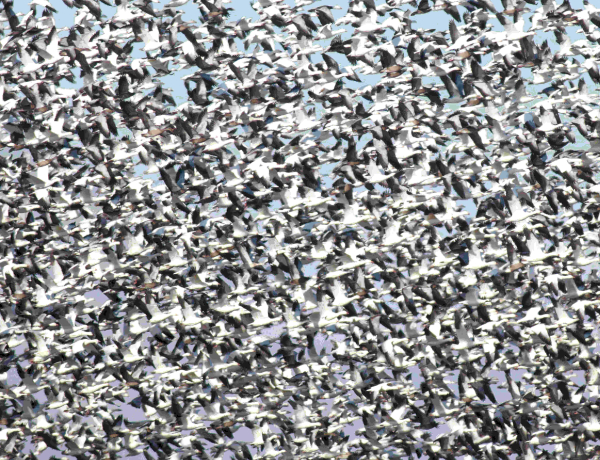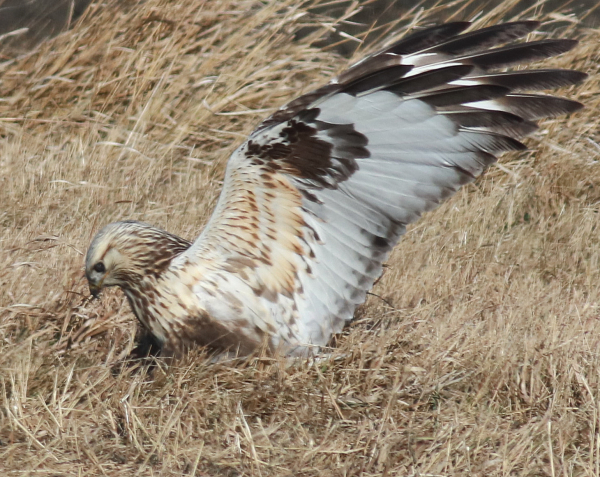
Snow Geese dominate the birds in Paul’s neighborhood, with blue and white color morphs mixed in the multitude of flocks. Although they are hard to discern in the field, Ross’s Geese also can be found in some flocks; 4 are present at the top of this photo.

A wall of Snow Geese in flight above a feeding site gives you an impression of the concentrations of birds in the huge flocks that abound in the region.

After photographing a successful vole hunt by a Rough-legged Hawk Saturday (see the Bird Photography feature in this issue), Sunday afternoon another Rough-leg provided an opportunity to photograph it catching a mouse (above).
|
Snow Geese have dominated the entire month of November in my neighborhood, and with the sounds of geese a constant, huge flocks of several tens of thousands of Snow Geese have been assembled the past two weeks north, south, and east of my Dakota office, providing spectacular flights of vast flocks of geese each morning and afternoon from the remaining ice-free lakes to feeding fields of harvested grains, primarily cornfields. Even with daily access to such spectacular scenes, and years and decades of similar experiences, I never tire of the sights, sounds, or energy created by such remarkable concentrations of birds.
Not everyone reacts to this wealth of Snow Geese like me, and even as I exuberantly describe my excitement to many people – friends, family, associates, and anyone who I visit with via telephone or text and email – it often seems that it’s “like trying to explain rock and roll.” I just figure I’m lucky to enjoy these Snow Geese scenes with such gusto, and absorb the natural energy created, not unlike being close to giant waterfalls or huge ocean waves – ya gotta be there!
Saturday evening, Snow Goose numbers seemed to peak to a point that I don’t believe I’ve ever witnessed before! I could see large continuous flocks of Snow Geese from horizon to horizon, flying in every direction, criss-crossing at different altitudes – literally filling the sky. Eventually individual flocks formed a huge cloudlike swarm that circled and spun into the corn-covered ground to feast on harvest “waste” corn that the geese vacuum as they move across the field that is literally turned white with the appearance of a snow-covered landscape – until they flush up en masse, only to spin around and repopulate the surface white again.
Only a few of the deepest lakes in the area still have open water, although some of these are partly ice-covered. Most of the freezing takes place after dark when temperatures cool from the 30s or 40s to the 20s or teens, and that makes keeping the water open a losing proposition. However, the geese seem perfectly fine with standing on the ice, or just staying in the field after feeding, many just lying down to rest. As long as there is no snow covering the ag fields, the geese are liable to stay and feed – and it looks like waste grains will be snow-free at least through early December. That’s tough to beat, and it extends this late season of goose music.
I was interested to check out the bigger picture of where Snow Geese have concentrated in this region, so I drove north 60 miles and counted 13 huge flocks numbering tens of thousands of Snow Geese each along the way! During recent trips to Bismarck and Fargo, I checked out areas to the west and east too – 100 miles in each direction on each end of that 60-mile transect, but aside from 3 huge flocks around the Spiritwood area east of Jamestown, the Snows seemed to be most common along the eastern edge of the Missouri Coteau, which runs through my neighborhood on a north-south axis.
When I extended my search north another 20 miles along the Coteau edge, I found no Snows north of that 60 mile line, which made me wish for an opportunity to do an aerial survey of the greater south-central region of North Dakota to get an overview of the distribution of Snow Geese during this peak of their abundance. Even so, by now the Central Flyway Snow Goose population is likely sprinkled in the tens of thousands across the Great Plains from Saskatchewan and Manitoba to Nebraska and Kansas with a few already beginning their winter vacations along the Gulf Coast of east Texas and Louisiana, switching their menu from corn to rice, along with plenty of fresh greens.
First of Fall Sightings
As fall extends its season in this northern land, I was glad to see the first small flocks of Snow Buntings. Last Tuesday I spied, 2 other first of fall species present on a cold deep lake a few miles to the north – Common Goldeneyes and Common Mergansers. These two duck species are traditionally the latest fall waterfowl arrivals, and they usually reach peak numbers a day or 2 before total freeze-up. And when I least expected it, a first of fall male Eastern Bluebird availed itself to my view a short distance east of home. I certainly didn’t see the numbers of bluebirds I usually see during late summer and fall this year – only this one; but this area is beyond their usual range at this time – we used to say that about Snow Geese too – things change.
Raptor Excitement
Saturday morning, as I stepped out the door I looked north to see an adult Bald Eagle flying my way; and then another. They veered to the southeast. A half-mile north of home a third adult Bald Eagle angled my way. And another half-mile north, as I focused on a hunting Rough-legged Hawk, a forth Bald Eagle flew into view behind the hawk, angling to the southeast – 4 eagles and a hawk in my first mile; “must be a migration happening today,” I thought; but those were the only raptors I observed – ha!
I describe the resulting memorable photo session with the Rough-legged Hawk in this week’s Bird Photography feature that’s illustrated with 5 of the resulting photos. With Arctic-nesting Rough-legged Hawks passing through the area in force the past 3 weeks – more than I can recall – I’ve been alert for my first Snowy Owl sighting of late fall. Earlier last week I observed 5 Bald Eagles Thursday – 2 adults 6 miles south, 2 adults 4 miles north, and a white-belly immature Bald Eagle 7 miles north.
The Rough-legs and eagles will soon pass southward – many already have – but raptors will all but vacate this state for locations to the south. However, there will be plenty of raptors, beginning just 100 miles southwest, where my SoDak winter raptor hotspot begins. I look forward to photographing there soon – possibly as you read this – but with the threat of the pandemic, I will be limiting my usual overnight SoDak photo trips to day trips. That’s a lot of driving for one day of photography, but it’s always a highly rewarding and insightful field trip nonetheless.
Whether you are finding waterfowl or raptors, feeder birds or Wild Turkeys, enjoy your Thanksgiving weekend in the best ways possible, including some time outdoors birding. Happy Thanksgiving; stay happy, healthy, and safe.
Article and photographs by Paul Konrad
Share your bird sightings and photos at editorstbw2@gmail.com